By Barry Divola, Tom W. Clarke and John Shand
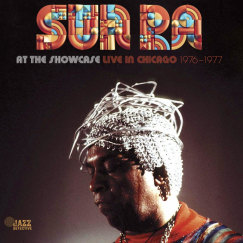
A showcase of Sun Ra at his zany, eccentric, ingenious best.
Sun Ra, Sun Ra at the Showcase: Live in Chicago 1976-1977
It’s not only hats, umbrellas and litter that blow around the windy city of Chicago: the draughts mess with the music, too, obscuring sources and encouraging invention. Chicago nurtured the blues’ acoustic-to-electric upheaval in the 1950s, and then fostered a uniquely holistic take on jazz espoused by the likes of the Art Ensemble of Chicago and Sun Ra – artists who dealt in the music’s history and future simultaneously.
Composer/keyboard player Sun Ra had been part of that history. Born Sonny Blount in Alabama in 1914, he had a vision in 1937 that led to his claiming to be a visitor from Saturn. No one blinked. A conscientious objector during WWII, he then became arranger for the once-great Fletcher Henderson’s fading big band, which proved far too limiting for his boundless ideas.
The 1950s saw him form bands – “arkestras”, he called them – that covered a gamut from doo-wop to the earliest jazz-based investigations of free improvisation. In fact, all elements of African-American musical history were options for Sun Ra, alongside many uniquely his own.
This thrilling double album was recorded live in Chicago in 1976 and 1977, long after he’d taken his Arkestra to New York and then Philadelphia to live and work as a music-focused cult-ish community. He attracted some of the world’s finest musicians – including tenor saxophonist John Gilmore and alto saxophonist Marshall Allen – by virtue of his imagination, artistry and wisdom, and because the Arkestra didn’t narrow their possibilities.
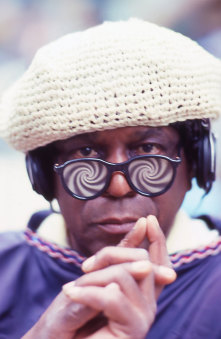
Sun Ra’s never-before-heard material is a must-have for jazz enthusiasts.Credit: Veryl Oakland
The never-before-heard material represents a celebratory homecoming of sorts, and features Gilmore at his most potent – and this from arguably the sole John Coltrane contemporary to scale vaguely comparable heights on his instrument. Allen is typically stirring throughout, too, providing the white caps to Gilmore’s great waves of sound.
Just as striking are Sun Ra’s playing and wildly diverse compositions. He concentrates on organ here, an instrument that he could make sound cheesy one moment and volcanic the next. On the groovy Moonship Journey and boppish Velvet, he follows Gilmour’s storming solos with childlike fantasies.
At first glance the decision to program the 1977 concert before the ’76 one seems almost as bizarre as the man himself, but in fact there’s a logic here because the ’77 material comprises that night’s first set, while the ’76 concert contributes that night’s second. The latter begins with an ominous organ introduction to Calling Planet Earth & the Shadow World, a piece which represents Sun Ra at his zany, eccentric, ingenious best, with the notes at one point cascading from the keyboard like a shower of coins.
Meanwhile, Marshall Allen’s alto solo will rearrange your viscera, even as it lights up long-dormant parts of the brain, and there’s also a wildly exuberant version of Space is the Place. No Sun Ra collection is complete without this treasure, and for the uninitiated it’s a mind-expanding doorway to his intergalactic world. John Shand
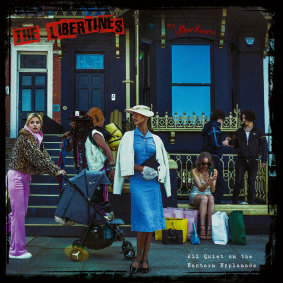
The Libertines’ All Quiet on the Eastern Esplanade: Songs of regret, songs of survival.
The Libertines, All Quiet on the Eastern Esplanade
Not too many people would have laid bets on Pete Doherty of The Libertines making it out of his twenties. The obituaries were written years ago, just waiting for the inevitable announcement. The tabloid tales of his manifold addictions, his hedonism and his self-destructive nature were legion.
And yet, at the age of 45, not only is he still around, but the band he formed in the late ’90s with his soulmate, songwriting partner and co-lead singer Carl Barat is still together and they’ve made it to their fourth album.
Despite the fact the four band members – including drummer Gary Powell and bass player John Hassall – are spread out across London, France, Denmark and Margate in south-east England, All Quiet on the Eastern Esplanade is a decidedly cohesive band effort. It was recorded at the Albion Rooms, a studio they established in Margate, there’s a real sense of four guys in a room, and a few songs end with the sound of laughter and joking around.
Opening track Run Run Run is quite possibly the catchiest song of the band’s career. Barat has called it a song of hope, set to a rallying drum beat, slashing guitars and a rousing chorus designed for shouting along to, with your arms around your mates: “You better run, run, run boys, faster than the past.” It’s the first of many lines that are all too easily translated as references to overcoming a troubled life.
Later, Shiver offsets a bubbly, tumbling feel with an even more explicit line: “Resist to stay alive, not to die at 25”. And Be Young has a Clash-like swagger and the cautionary lyric, “You’re one degree away from total and utter f---ing annihilation.”
It’s not all the Pete and Carl survival show, although a couple of tracks that look outwards can have somewhat murky interpretations. Mustang is about a day-drinking mum in a Juicy Couture tracksuit, but it comes across as sneering rather than sympathetic. And the jaunty Merry Old England references immigrants from Syria, Iraq and the Ukraine and asks, “Is it everything that you dreamed of?” . Perhaps their hearts were in the right place, but that question could also be a threat coming out of the mouth of a leering drunk bloke outside a London pub on a Saturday night.
And musically, it’s not all breathless British post-punk. You can imagine Tom Waits covering Baron’s Claw, a cracked baroque tale of a disturbed ex-army officer. And Night of the Hunter, which was inspired by the 1955 noir thriller starring Robert Mitchum as a killer with “LOVE” and “HATE” tattooed across his knuckles, has a spooked Morricone-like feel and the melody of Swan Lake played on a theremin.
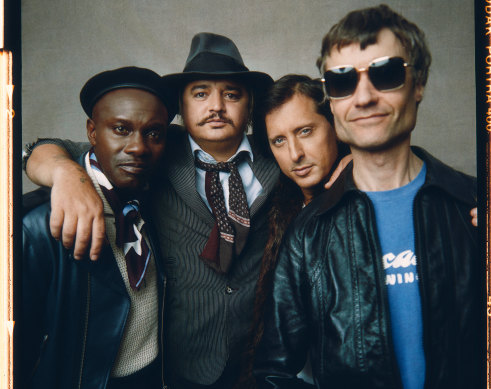
The likely lads live: Gary Powell, Pete Doherty, Carl Barat and John Hassall of The Libertines.
Closing track Songs They Never Play on the Radio will be familiar to die-hard Libertines fans, as Doherty has been tinkering with it since 2006. It’s a heartbreaker of a melody sung over a descending bass line, with Doherty crooning “since 45s are digitised this heart’s bereft” and “men of my class who live too fast and we can’t be arsed and batten down the hatches.”
It’s a song about regrets, but years after Doherty first wrote it, it now sounds more like a song of survival. And after it ends, they all howl like dogs, fall about laughing, then someone continues strumming an acoustic guitar and they start things up again, harmonising together at the fade-out. It’s almost like they don’t want things to end. Barry Divola
Girl In Red, I’m Doing It Again Baby!
It’s been two-and-a-half years since Marie Ulven, better known as Girl in Red, released her debut album If I Could Make It Go Quiet. The Norwegian singer-songwriter hasn’t exactly been MIA since then – she has played several major music festivals and accompanied Taylor Swift for part of the Eras Tour – but for her loyal fan base, it’s been a long wait.
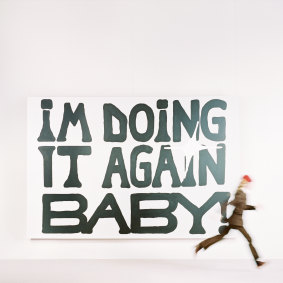
Girl in Red’s I’m Doing It Again Baby!: Scattershot, but at her best when baring her soul.
I’m Back, the opening track on I’m Doing It Again Baby!, addresses this absence immediately with a sentiment that serves as a mission statement for the whole album: “I’m back, I feel like myself/ I was gone for a minute/ ’Cause I went to get help.” The tinkling keys, soft lilting vocal, and arresting vulnerability open the gate to Ulven’s labyrinthine mind and personal journey. It’s uplifting and reflective, relatable and open.
Unfortunately, the record as a whole is frustratingly inconsistent, with excellent moments often obscured in a sonic washing machine that sloshes wildly between styles, sounds and quality.
At 25, Girl in Red is already an alt-pop fixture – a level above indie artists like Maggie Rogers and Holly Humberstone, not yet on the level of world-conquering hitmakers like Billie Eilish and Olivia Rodrigo. The album’s weakest moments often feel like grabs for that mainstream audience, but there isn’t quite a Bad Guy or Good 4 U on this album.
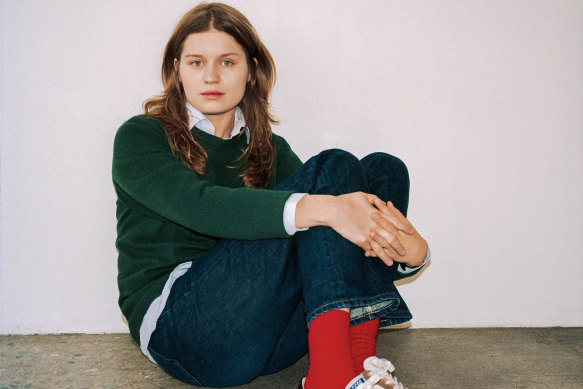
Girl in Red, aka 25-year-old Norwegian alt-pop star Marie Ulven Ringheim.
The title track, a sanitised club banger that feels destined for a Kia ad, is high energy pop-rock fuelled by empty calories. It’s a similar case on the break-up track You Need Me Now?, which features Sabrina Carpenter, introduced in an admittedly ballsy bridge where Girl in Red states, “You know what would be really f---ing cool on this? Sabrina! Like, if we could get Sabrina on this...” , only for Sabrina to slide in with, “Oh my God, you’re so right, I’m going to sing now.” It’s the kind of song that feels manufactured as an ‘event’, but fails to live up to the title.
Ulven is at her best when she’s baring her soul, flexing her skill as a lyricist and utilising her smoky, sanguine vocal to open up and invite people into her story in ways few pop stars do. Lead single Too Much is pure delight, as Ulven pushes back against the all-too-common human instinct to minimise and reject anyone idiosyncratic or different. It’s defiant and propulsive, building from bouncy keys into eminently danceable pop-punk.
The album’s best moment is A Night to Remember – Girl in Red is a queer icon, and this track is sure to cement her among the world’s most prominent queer musical influences. It’s a stunning achievement, a song that details Ulven meeting her current girlfriend, one that perfectly captures the feeling of falling instantly, deeply in love – from the moment of attraction, to the thrill of meeting and the explosion as lust transforms into love, and finally, the desperately powerful feeling of true acceptance.
And on Ugly Side, Ulven walks a fascinating tightrope, presenting some of her darkest and most intrusive thoughts alongside a funky, swaggering beat that allows the song to float rather than slip into an abyss.
This is an album about overcoming your most negative self-talk and emerging a stronger version of yourself. It’s scattershot and a little incohesive, but aren’t those the sounds of true healing? The best moments on this record suggest the highest heights of alt-pop stardom aren’t far away. Tom W. Clarke
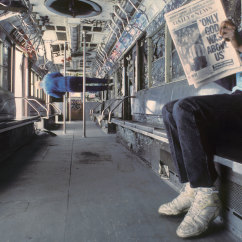
Vampire Weekend’s Only God Was Above Us: Is there hope in no hope?
Vampire Weekend, Only God Was Above Us
If Wes Anderson and Donna Tartt had ever collaborated and come up with a fictional band, it would have looked and sounded an awful lot like Vampire Weekend.
They were the weird fish in the pool that spawned the New York rock revival of the noughties, arriving in the mid-2000s looking preppy and nerdy, with polo shirts and floppy hair. While bands from The Strokes to LCD Soundsystem built their sound by rejigging and reconfiguring a post-punk world that spanned the dingy downtown rock club and the dingy downtown dance floor, Vampire Weekend were more Upper West Side and bounced sprightly ska-pop off springy Afro-pop.
The guitars were clean, sparkling and trebly. The rhythms were rickety and complex. The keyboards whistled and whirred. Ezra Koenig sang like a cross between a choirboy and David Byrne – in fact, the smart-nerd aesthetic and herky-jerky music of early Talking Heads is probably the closest comparison for what they were doing.
Their songs referred to Mansard roofs and characters from US college campus life. On early single Cape Cod Kwassa Kwassa, they built a bridge between the moneyed US north-east and the Congo. And on Oxford Comma (key line: “who gives a f--- about an Oxford comma?” ), they became the only band to ever direct their twenty-something angst towards the use of a punctuation mark.
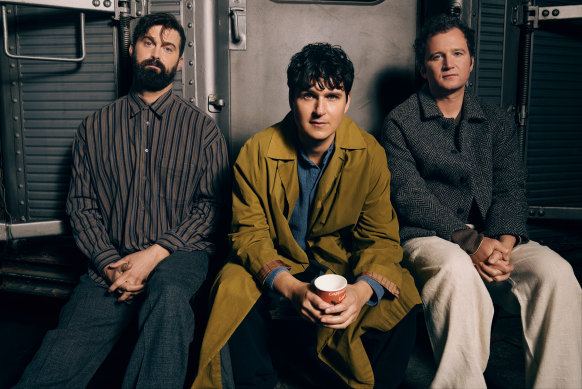
Vampire Weekend: (from left) Chris Tomson, Ezra Koenig and Chris Baio.Credit: Daniel Pakopcyk
The band’s last record, 2019’s Father of the Bride, was something of a concept album about marriage, with many songs based around more traditional song structures. With that said, the band – even minus founding member and producer Rostam Batmanglij, who departed after 2013’s Modern Vampires of the City – always pull things apart and add oblique angles, so a simple four-chord strum could quickly be swamped with distorted keyboards, a clattering beat or a choir, while on a couple of songs Danielle Haim (of sister trio Haim) played Nancy Sinatra to Koenig’s Lee Hazlewood.
Now, on their fifth album, what’s changed? Well, for Koenig, quite a bit. He has moved to Los Angeles – his partner is actor Rashida Jones, and they have a young son – contributed to soundtracks, including Peter Rabbit, Booksmart and Champions, and co-written songs for Liam Gallagher and Beyoncé.
On Only God Was Above Us – the title comes from a newspaper headline about a plane crash, featured in the 1988 photo by Steven Siegel on the album cover – it sounds like Koenig is in a New York state of mind. The videos for Capricorn and Gen-X Cops teem with footage of the city, while the lyrics are dotted with references to the metropolis: “I know what’s buried beneath Manhattan”; “came in from Jersey, not from Brooklyn”; “I had a job once in Penn Station”.
There’s also a decided sense of gloom or at least a sense that Koenig is grimacing at the world we’re living in right now. A decade ago, he might have quipped about it or found a way to skewer it; now you can tell he’s affected by it. The first line he utters is, “‘F--- the world’, you said it quiet, no one could hear you, no one but me.”
On Capricorn, over a rattling snare drum, trickling piano and chugging strings, he wonders who’s in control of the future and, almost with a resigned sigh, sings that he’s “too old for dyin’ young, too young to live alone.”
Musically, the band is going more for the head than the heart, more suited for headphones than speakers: the dub-influenced, spacey echo of The Surfer; the weird mix of baroque and dance-pop on Connect; the squealing, fuzzed-out keyboard and a wild sax break by Henry Solomon on Classical.
The final track is an almost eight-minute opus called Hope. And despite that title, the song is more about giving up than embracing optimism.
“I hope you let it go,” sings Koenig. “I hope you let it go. The enemy’s invincible. I hope you let it go.”
Whether he’s being zen or throwing his hands up in surrender is unclear. Barry Divola
To read more from Spectrum, visit our page here.